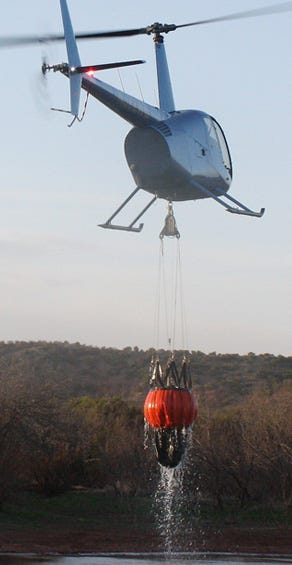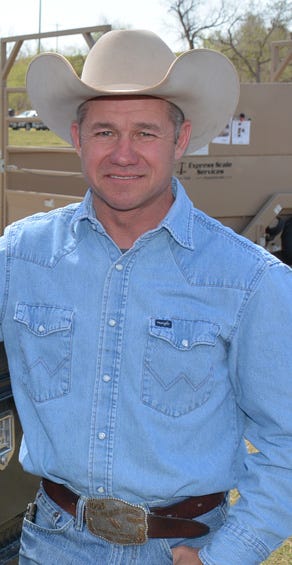
Severe to exceptional drought conditions continue to plague the Texas Plains, leaving the fire danger high and volunteer fire departments (VFD) throughout the Texas Panhandle on high alert.
While volunteer firefighters risk their lives on the ground defending people, livestock, structures and land, a trio of volunteer pilots battle the blaze from the sky.
“The volunteer fire departments are the true heroes putting out the fires, we are just trying to help them out,” says rancher and pilot Jason Abraham of Canadian, Texas. “We are another tool for them to get some eyes in the sky and drop some water in strategic spots to help them out.”
Abraham is one of three volunteer pilots that primarily serves the eastern Panhandle. When area VFDs request their assistance, Abraham along with rancher and pilot Andrew Bivins, Amarillo, Texas, and pilot Trey Webb, CEO of Flap-Air Helicopter, Canadian, volunteer their time along with their helicopters.

Volunteer helicopter pilots fill their Bambi bucket with water, help VFDs fight fires.
“We don’t self-deploy on fires — if we hear about a fire, we wait until we are called,” says Bivins of JA Ranch. “We feel that is a safety thing. We need and want the Incident Commander (IC) of the fire to have absolute control of their fire and all resources on it.”
Once Bivins and his fellow helicopter pilots deploy, they evaluate the fire from the air and develop a strategy with the IC. “Before air resources are mobilized by the Texas Forest Service and it’s only the local volunteer firemen on the ground, I can get up and take a quick look, land and meet with them or pull up a map and say, ‘There’s a great road over here, there’s rough canyons or a terrible spot here with no access, there’s a house here, here and here,’ and we can start forming a strategy based on the best and safest way to protect all people on the fire, any structures, livestock and vegetation.
“Often we can go up there, be the initial attack on the front of the fire where it’s not safe to be on the ground and try to cool it off and possibly slow or stop it,” he says.
The aerial firefighting services provided by the pilots are free. “We are all blessed and it’s one of the ways that we can give back to our communities,” says Bivins. “I think the VFD’s feel we will charge them but if they can use us we are happy to help.”
An asset vs. a liabitlity
Abraham began using his helicopter to fight fires following a 2006 blaze that consumed 10,000 acres of his Mendota Ranch.

Rancher and volunteer pilot Jason Abraham
“That was really the first big fire I had ever seen. There were two fires that day and both burned about a half-a-million acres,” says Abraham, who’s been a pilot for 24 years. “What stuck in my mind was I wanted to do something and I couldn’t. But now I can. I position myself now where I can be an asset instead of a liability.”
The pilots fly Robinson R44 helicopters. The light aircraft can pack 75 gallons of water in their Bambi bucket, loading every 30 seconds. Abraham says the helicopters, though smaller than the R66s they used to fly, can be in the air for three to four hours.
“The neat thing about being a little helicopter with a little bucket and enough fuel, is we never leave the fire. When you see these big airplanes or SEATS (Single Engine Air Tankers) come in there, they drop and then they are gone. We never leave. We’re always there, always in touch with the fire department. And if anyone gets hurt, we can get them picked up or call for paramedics and guide them in to pick them up,” Abraham says.
The helicopters extract water from, “anywhere they can,” he says. “It needs to be about 3 to 3.5 feet deep for us to scoop the water out of it. We’ve got a trailer built that has our fuel on it and a tank that’s about 8-foot deep and 8-foot wide. We pull the tanker up to it and we can dip out of that if we need to. We’d just soon not, we’d just soon dip out of a dirt tank that’s handy — takes less time.”
Since 2011, when drought conditions were like what they are today, Abraham says they have been busy fighting fires from the sky. “Every time we think it’s over we get another dry spell. That’s where we are right now. We came into this year with a lot of fuel. We didn’t have a lot of rain but when we did, it was timed right so that we grew some. What fuel is left over is burning in these big fires with high winds.”
Lightning storm
A recent May lightning storm ignited five wildfires on Bivins’ drought-struck JA Ranch, southeast of Amarillo, consuming 37,000 acres — 80,000 total on what was known as the Mallard Fire. Bivins, who assisted with fire suppression with his helicopter, witnessed fire behavior like he’s never seen before.
“I’ve never seen a fire like this before in my life, how volatile all the different fuels were. I saw spotting — when the head of the fire throws up embers that then land in front of the fire starting a new fire — of 100 yards, and I’m going to guess, 500 yards, at one point, which is just incredible. What we normally see is 30 feet,” Bivins describes.
After coordinating with the Armstrong and Donley County VFD fire chiefs and the Texas Forest Service, both Bivins and Abraham spent a day on the southern end of the fire or the heel of the fire, making drops to prevent the flames from crossing a creek. “If it crossed, it would have burned another 20,000 acres. We were able to monitor and handle the southern end of the fire while bigger resources were diverted to stopping the fire and protecting the structures up north,” says Bivins.
When asked if it was difficult to fight fires on his own ranch, Bivins says it was all black and white until he issued the call to evacuate his historic ranch headquarters.
“Firefighting from the air is extremely demanding work. The focus is more on the global strategy of how to contain and stop the fire safely rather than trying to protect certain acres. Our headquarters was in the back of mind the entire time and at one point I had to make the call to evacuate headquarters. That was emotionally tough but it was a black and white fact — we just needed to do it to keep everything safe.
“The house was built in the 1900s, so the history of the place and growing up there and my mom living there, all the families that were there and their children, having to tell everyone to pack up any of their valuables and personal items that they might want to keep and know that their place might burn down — it’s hard enough to tell a stranger that. But whether the fire is on my ranch or on someone else, the strategy for how we fight fire is still the same.”
Volunteer Fire Departments
Northeast of Amarillo, Canadian VFD firefighter and department Chief Scott Brewster says the helicopter trio has helped his department fight fires in locations unreachable on foot.
“They can dump water on these canyons in the ravines where we can’t get to it,” says veteran firefighter Brewster. “We’re there to help put out the fire so it doesn’t burn up someone’s place more than it really needs to. If I need them, then I’m in that helicopter with them. When you get in the air, you can see so much more than you can on the ground.”
Brewster, who’s been fighting fires for 27 years, says the helicopters are especially helpful in large fires, allowing him to coordinate resources and firefighters from the air, guiding them into the ranches or provided shortcuts to areas in need of suppression. “Instead of them going 20 miles out of their way, from the air I can tell them which route to take to get there in maybe five minutes,” says Brewster.
During the day, Brewster is a supervisor for the Canadian Highway Department. But when the call comes, he’s fighting fires. And while volunteers are the lifeblood of rural communities, being a volunteer firefighter requires a sacrifice of time and possibly their life.
“There’s a lot more involved being a volunteer firefighter than say volunteering with Little League or booster club. It’s a 365-days a year, 7 days a week, 24 hours a day deal. I don’t think people realize that a lot of the departments build their own trucks from the ground up and maintain them,” says Brewster, who’s department meets the second and fourth Wednesday of every month. “The meeting will start at 7:30 but my guys will be there at 6:00 working on something. We won’t get out of there until 11:00 — it’s like that every second and fourth Wednesday. And then if we have a fire (that’s more time). It really is a demanding volunteer organization.”
When asked why he’s committed 27 years of his life to it, Brewster says, he wants to help, to be a part of something good. “It takes a special breed of person to do what we do. I love doing it. There’s some stuff I’d rather not see but somebody’s got to take care of it and that’s us. Somebody has got to get that loved one back to them no matter what.”
Be a ranch asset
As the drought persists in many areas and therefore the fire danger, the firefighting pilots offer some advice to landowners:
1. Be a “ranch asset.” Rather than the landowner fighting the fire, he or she needs to be coordinating with the IC to identify water sources, gates, structures, livestock, roads and/or prioritize what needs to be saved or protected.
2. Do not use a cattle sprayer to try to fight the fire, unless otherwise directed by the IC. Follow his direction.
3. Avoid using small bumper pool spray trailers. When trying to turn around on a narrow dirt road in the heat of the moment of an approaching fire, the trailers easily get stuck or jack-knife, leaving those in the vehicle in the line of the fire.
4. Visit the TFS website for tips on how to create defensible space around your home.
“It’s not if a fire’s going to come on you, it’s when,” says Bivins. “In this part of the world, we don’t have many blizzards anymore and we may have a few tornadoes but by far we have wildfires.”
About the Author(s)
You May Also Like






